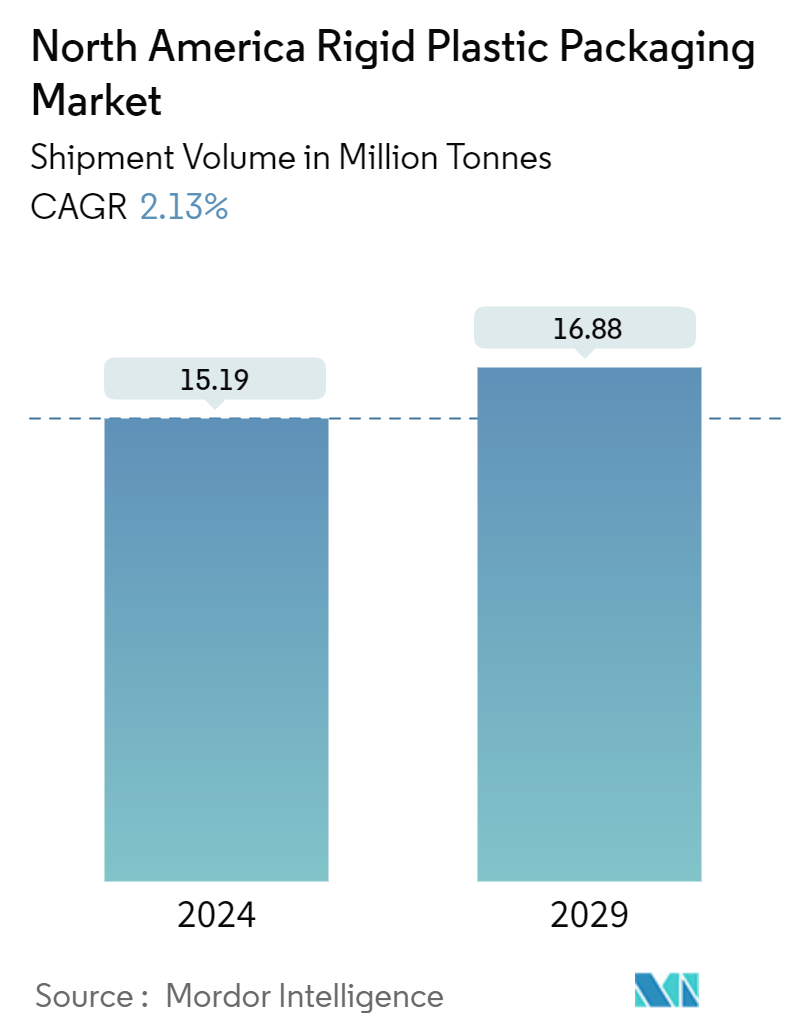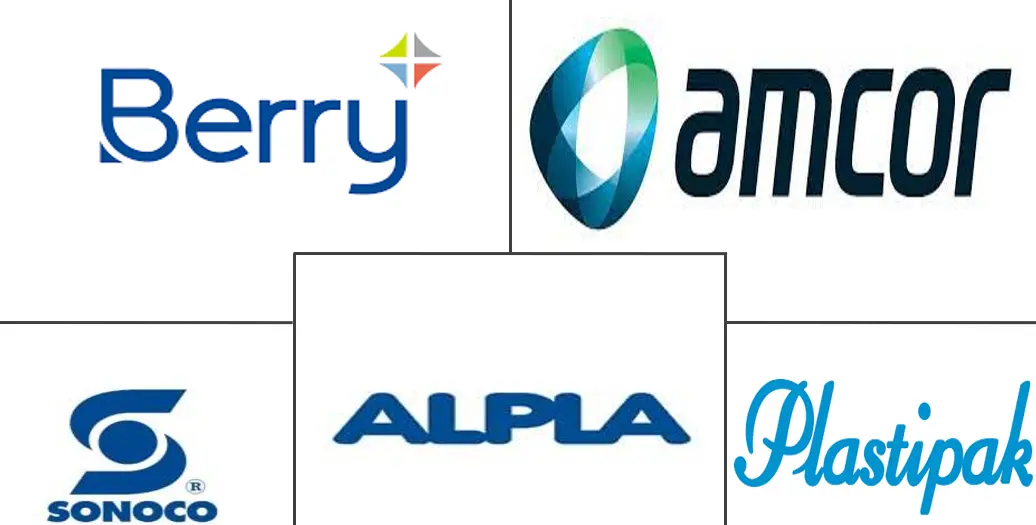Market Size of North America Rigid Plastic Packaging Industry

| Study Period | 2019 - 2029 |
| Base Year For Estimation | 2023 |
| Market Volume (2024) | 15.19 Million tonnes |
| Market Volume (2029) | 16.88 Million tonnes |
| CAGR (2024 - 2029) | 2.13 % |
| Market Concentration | Low |
Major Players
*Disclaimer: Major Players sorted in no particular order |
North America Rigid Plastic Packaging Market Analysis
The North America Rigid Plastic Packaging Market size in terms of shipment volume is expected to grow from 15.19 Million tonnes in 2024 to 16.88 Million tonnes by 2029, at a CAGR of 2.13% during the forecast period (2024-2029).
As the consumption and production of goods in the consumer and industrial sectors continue to grow, the demand for rigid plastic packaging materials that can withstand harsh conditions without compromising the product's quality is increasing.
- The plastic bottles market in North America is projected to experience a steady increase due to the growing consumption of plastic-based containers and their industrial applications. According to the Plastics Industry Association, the market for plastic bottles in the United States is expanding.
- Driven by soaring innovations, North America's rigid thermoform plastic packaging market is witnessing significant growth. The advantages of thermoforming, such as cost reduction and versatility, play a pivotal role in this surge. The burgeoning manufacturing of products, coupled with a vast customer base, is also fueling the expansion of the rigid plastic packaging market in North America.
- PET plastic packaging is used in over 70% of beverage bottles because of its lightweight, transparent, and 100% recyclable properties. PET plastic containers produce less solid waste than glass and aluminum containers, consume less water during manufacturing, and generate fewer emissions associated with acid rain and smog emissions.
- According to the LCA (Life Cycle Assessment) presented by the National Association for PET Container Resources, NAPCOR (National Association for the Packaging Industry of the United States, Canada, and Mexico), the negative environmental impact of PET bottles is significantly lower than that of the glass and aluminum containers.
- The need to recycle PET into food-grade products, like beverage containers, is a growing concern for many global companies. This can lead to an increase in demand for PET across the region. For example, according to a recent report, Coca-Cola aims to use 50% recycled PET in its containers by 2030. Similarly, Unilever aims to make 100% of its plastic packaging recyclable or reusable by 2025.
- However, the use of plastic will likely slow down over time as people become more aware of environmental issues. More and more people in the United States and Canada are switching to environmentally friendly packaging materials. Governments in these countries have imposed stringent rules and regulations on plastics and plastic products due to their potentially harmful environmental effects. This has made it a relatively slow-growing market compared to other materials.
North America Rigid Plastic Packaging Industry Segmentation
The study tracks the demand for rigid plastic packaging materials across various end-user industries, such as food, foodservice, beverage, healthcare, personal care, cosmetics, industrial, building and construction, and automotive. Rigid plastics can be of different grades and different material combinations based on the type of product being packed, like polyethylene, polypropylene, polyvinyl chloride, polyethylene terephthalate, and bio-plastics.
The North American rigid plastic packaging market is segmented by resin type (polyethylene (PE) (low-density polyethylene (LDPE) & linear low-density polyethylene (LLDPE) and high-density polyethylene (HDPE)), polyethylene terephthalate (PET), polypropylene (PP), polystyrene (PS) and expanded polystyrene (EPS), polyvinyl chloride (PVC), and other resin types), product type (bottles and jars, trays and containers, caps and closures, intermediate bulk containers (IBCs), drums, pallets, and other product types), end-user industry (food (candy & confectionery, frozen foods, fresh produce, dairy products, dry foods, meat, poultry, and seafood, pet food, and other food products), foodservice (quick service restaurants (QSRs), full service restaurants (FSRs), coffee and snack outlets, retail establishments, institutional, hospitality, and others foodservice sectors), beverages, healthcare, cosmetics and personal care, industrial, building and construction, automotive, and other end-user industries), and country (the United States and Canada). The market sizes and forecasts are provided in terms of volume (tonnes) for all the above segments.
| By Resin Type | ||||
| ||||
| Polyethylene terephthalate (PET) | ||||
| Polypropylene (PP) | ||||
| Polystyrene (PS) and Expanded polystyrene (EPS) | ||||
| Polyvinyl chloride (PVC) | ||||
| Other Resin Types |
| By Product Type | |
| Bottles and Jars | |
| Trays and Containers | |
| Caps and Closures | |
| Intermediate Bulk Containers (IBCs) | |
| Drums | |
| Pallets | |
| Other Product Types |
| By End-use Industries | ||||||||||
| ||||||||||
| ||||||||||
| Beverage | ||||||||||
| Healthcare | ||||||||||
| Cosmetics and Personal Care | ||||||||||
| Industrial | ||||||||||
| Building and Construction | ||||||||||
| Automotive | ||||||||||
| Other End User Industries |
| By Country | |
| United States | |
| Canada |
North America Rigid Plastic Packaging Market Size Summary
The North America rigid plastic packaging market is poised for moderate growth over the forecast period, driven by increasing demand in both consumer and industrial sectors. The market is characterized by the rising consumption of plastic-based containers, particularly in the United States, where the plastic bottle segment is expected to see steady demand. This growth is supported by the advantages of PET plastic packaging, which is widely used due to its lightweight, transparent, and recyclable properties. Despite the environmental concerns associated with plastic use, PET remains a preferred material for beverage containers, offering benefits such as reduced solid waste and lower manufacturing water consumption. However, the market faces challenges from environmental regulations and the shift towards eco-friendly packaging alternatives, which could temper growth.
The market dynamics are further influenced by geopolitical factors, such as the Russia-Ukraine conflict, which has led to increased raw material costs and supply chain disruptions. The demand for rigid plastic packaging is also bolstered by the expanding agricultural exports and the growing e-commerce sector in the United States, which necessitate efficient packaging solutions. The food and beverage industry, particularly the non-alcoholic beverage segment, is a significant contributor to the market, with increasing sales of bottled water and other beverages driving the need for packaging materials. Key players in the market, such as Berry Global Inc. and Amcor Group GmbH, are actively innovating and collaborating to enhance packaging solutions, including the incorporation of recycled materials, to meet evolving consumer and regulatory demands.
North America Rigid Plastic Packaging Market Size - Table of Contents
-
1. MARKET INSIGHTS
-
1.1 Market Overview
-
1.2 Industry Value Chain Analysis
-
1.3 Industry Attractiveness - Porter's Five Forces Analysis
-
1.3.1 Bargaining Power of Suppliers
-
1.3.2 Bargaining Power of Buyers/Consumers
-
1.3.3 Threat of New Entrants
-
1.3.4 Threat of Substitutes
-
1.3.5 Intensity of Competitive Rivalry
-
-
1.4 Trade Scenario
-
1.4.1 Trade Analysis (Top 5 Import-Export Countries)
-
-
1.5 Industry Regulation, Policy and Standards
-
1.6 Technology Landscape
-
1.7 Pricing Trend Analysis
-
1.7.1 Plastic Resins (Current Pricing and Historic Trends)
-
-
-
2. MARKET SEGMENTATION
-
2.1 By Resin Type
-
2.1.1 Polyethylene (PE)
-
2.1.1.1 Low-Density Polyethylene (LDPE) & Linear Low-Density Polyethylene (LLDPE)
-
2.1.1.2 High Density Polyethylene (HDPE)
-
-
2.1.2 Polyethylene terephthalate (PET)
-
2.1.3 Polypropylene (PP)
-
2.1.4 Polystyrene (PS) and Expanded polystyrene (EPS)
-
2.1.5 Polyvinyl chloride (PVC)
-
2.1.6 Other Resin Types
-
-
2.2 By Product Type
-
2.2.1 Bottles and Jars
-
2.2.2 Trays and Containers
-
2.2.3 Caps and Closures
-
2.2.4 Intermediate Bulk Containers (IBCs)
-
2.2.5 Drums
-
2.2.6 Pallets
-
2.2.7 Other Product Types
-
-
2.3 By End-use Industries
-
2.3.1 Food
-
2.3.1.1 Candy & Confectionery
-
2.3.1.2 Frozen Foods
-
2.3.1.3 Fresh Produce
-
2.3.1.4 Dairy Products
-
2.3.1.5 Dry Foods
-
2.3.1.6 Meat, Poultry, And Seafood
-
2.3.1.7 Pet Food
-
2.3.1.8 Other Food Products
-
-
2.3.2 Foodservice
-
2.3.2.1 Quick Service Restaurants (QSRs)
-
2.3.2.2 Full-Service Restaurants (FSRs)
-
2.3.2.3 Coffee and Snack Outlets
-
2.3.2.4 Retail Establishments
-
2.3.2.5 Institutional
-
2.3.2.6 Hospitality
-
2.3.2.7 Others Foodservice Sectors
-
-
2.3.3 Beverage
-
2.3.4 Healthcare
-
2.3.5 Cosmetics and Personal Care
-
2.3.6 Industrial
-
2.3.7 Building and Construction
-
2.3.8 Automotive
-
2.3.9 Other End User Industries
-
-
2.4 By Country
-
2.4.1 United States
-
2.4.2 Canada
-
-
North America Rigid Plastic Packaging Market Size FAQs
How big is the North America Rigid Plastic Packaging Market?
The North America Rigid Plastic Packaging Market size is expected to reach 15.19 million tonnes in 2024 and grow at a CAGR of 2.13% to reach 16.88 million tonnes by 2029.
What is the current North America Rigid Plastic Packaging Market size?
In 2024, the North America Rigid Plastic Packaging Market size is expected to reach 15.19 million tonnes.

